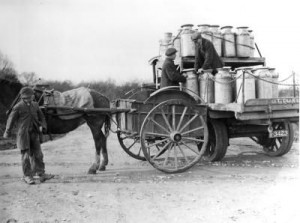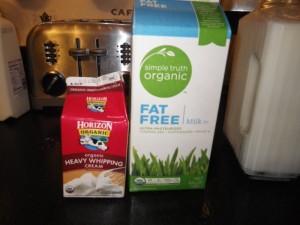Milk: It Does a Body Good?
 In the mid-nineteenth century, dirty dairies providing tainted milk to cities caused outbreaks of tuburculosis and other sickness that resulted in a number of fatalities. Rather than setting good standards for clean dairies and good handling practices, the solution was to pasteurize milk.
In the mid-nineteenth century, dirty dairies providing tainted milk to cities caused outbreaks of tuburculosis and other sickness that resulted in a number of fatalities. Rather than setting good standards for clean dairies and good handling practices, the solution was to pasteurize milk.
Pasteurization is the accepted method of controlling harmful bacteria in milk by heating it to a specific temperature for a specific amount of time, followed by quick cooling. In the process of pasteurization, however, the nutritional value of milk is destroyed. You lose a significant of amount of vitamin-B complex, vitamin A, vitamin C, calcium is diminished, proteins are harmed, and enzymes are destroyed.
According to Rob Schmid, in The Untold Story of Milk:
…this once vital food has been tarnished with the black brush of modern processing. [Milk has declined] from wholesome to noxious food; confinement diaries, inappropriate feed, horrendous processing, removal of the fat and the addition of problematic compounds — all have taken their toll on milk’s delicate nutritional balance.
 Later, milk was also homogenized, which is a process that breaks down the fat particles in milk (so that the fat does not separate to the top), further altering the original, natural composition of one of God’s perfect foods. This process extends the shelf life of milk so that it can be transported over longer distances without spoiling. Additionally, it keeps the fat from clumping at the top (separating the curd from the whey) giving the milk a more uniform “attractive” and marketable appearance. Well trained and well behaved consumers purchase more marketable and attractively packaged things, right?
Later, milk was also homogenized, which is a process that breaks down the fat particles in milk (so that the fat does not separate to the top), further altering the original, natural composition of one of God’s perfect foods. This process extends the shelf life of milk so that it can be transported over longer distances without spoiling. Additionally, it keeps the fat from clumping at the top (separating the curd from the whey) giving the milk a more uniform “attractive” and marketable appearance. Well trained and well behaved consumers purchase more marketable and attractively packaged things, right?
Kurt A. Oster, M.D., and Donald J. Ross, PhD, authors of The XO Factor, have researched the milk enzyme, xanthine oxidase. The homogenization process that makes the fat particles smaller in milk allow the enzyme to enter the blood stream, where it damages arterial walls leading to heart disease. The Untold Story of Milk states that:
The incorporation of proteins into the fat globule membrane alone may account for the increased allergenicity of modern processed milk.
In other words, a case of apparent lactose intolerance may simply be a case homogenization intolerance. A case of apparent milk allergy may, in fact, be a case of the body’s natural immune response to the introduction of unnaturally processed milk enzymes.
So, what to do? It is nearly impossible to find milk that has not been pasteurized and homogenized. Organic milk only has an improvement as far as the original quality of the original milk — but the pasteurization and homogenization process still damages the final product.
If you have your own cow, you are in luck. Unfortunately, most of us don’t own a cow. If you’re in a state that has not made raw milk illegal, fresh raw milk from a clean dairy is the next best option. Raw milk from a local dairy that operates a clean facility is the best choice for milk for most of us.
However, I live in a state where raw milk is (disgustingly and ignorantly) illegal. I have found, at my local Whole Foods, a milk that is non-homogenized, low-temperature pasteurized…which is as close to raw as I can legally get without owning my own cow. But my “local” Whole Foods is more than 20 miles away so I can’t get there every day or even every week.
When I can’t get to Whole Foods, this is what I do:
I purchase organic fat-free milk, and organic heavy whipping cream. The cream is still pasteurized, but not homogenized. For every half gallon of fat-free milk, I mix in 2/3 cup of heavy cream. This gives me the same fat content as whole milk without the homogenization.

This by no means replaces the nutritional value of the milk that is destroyed in the pasteurization process, but it does keep the fats and enzymes that remain in the milk whole — not damaged by a homogenization process — and while not perfect, it is as close as I can get. In the meantime, I continue to look forward to the day we have our own dairy cow, and will continue to support legislation that will make raw milk legal to buy and sell again.
Hallee
I’m so grateful for your visit, today.
You would bless me if you added me to your ![]() feed reader or subscribed
feed reader or subscribed  via email.
via email.
You can also become a fan on ![]() Facebook or follow me on
Facebook or follow me on ![]() Twitter. I would love to see more of you!
Twitter. I would love to see more of you!


6 families (including us) in our circle take turns in driving 1.5 hrs (one way) each week to get our RAW dairy & grass fed meats from an Amish farm in PA. I DON’T CARE IF IT’S ILLEGAL!!! I WILL make the educated decisions on what my family consumes. I would drive 3 hours if needed or move out of this state & into a state that has this liberty. The more we push back the FDA, USDA & vote with our $$, we WILL get our way!
BTW, full fat milk is the best. The more you remove fat, the worse it is for your body.
The “Untold Story of Milk” was a great read! So interesting. We are fortunate to have a very reputable source of raw milk here in Northern CA. I realize many parts of the US do not have this luxury. Kudos to you for this post!
Yes, which is why we add the fat back in – non homogenized fat in the form of heavy whipping cream. What we put in creates a fat content equal to that of whole milk.
Do any of the dairies/farmers do herd shares in your area? You then “technically” own the cow or part of it and can have a portion of its produce. The closest to us that does this is still about 20 miles away from where we live (outside of Bowling Green) though.
I used to drink raw milk all the time when I stayed in farms in Ireland. Two words: HUGE DIFFERENCE!
And I never got sick.
I was very troubled by your comments about homogenization & where it damages arterial walls leading to heart disease. Please consider reading this article by Mary Enig: http://www.realmilk.com/homogenization.html
Closing paragraph: “The fact that Oster’s theory has been disproven does not mean that the homogenization process is benign. During homogenization there is a tremendous increase in surface area on the fat globules. The original fat globule membrane is lost and a new one is formed that incorporates a much greater portion of casein and whey proteins. This may account for the increased allergenicity of modern processed milk.”
Thanks for posting that info. That was surprising and disturbing to me as well. I’m glad it was disproven.